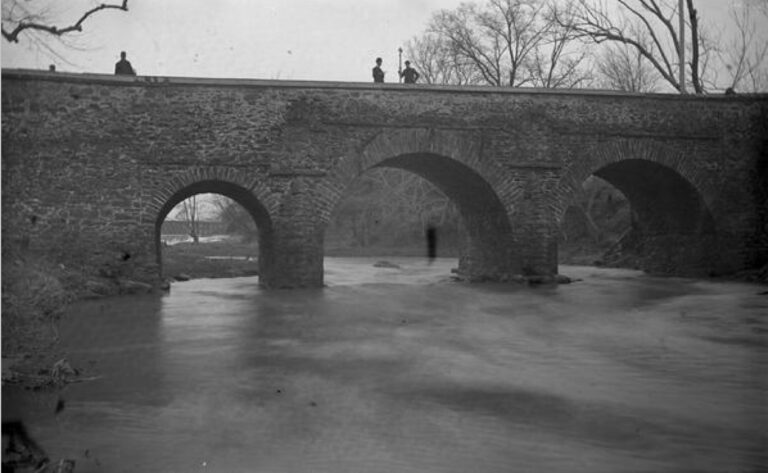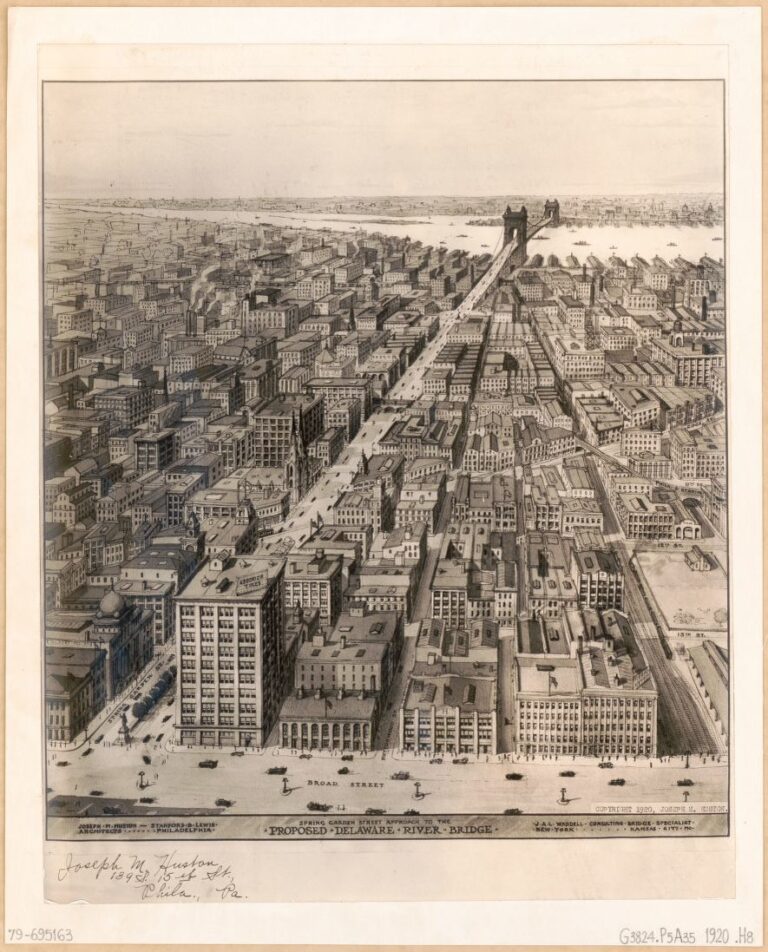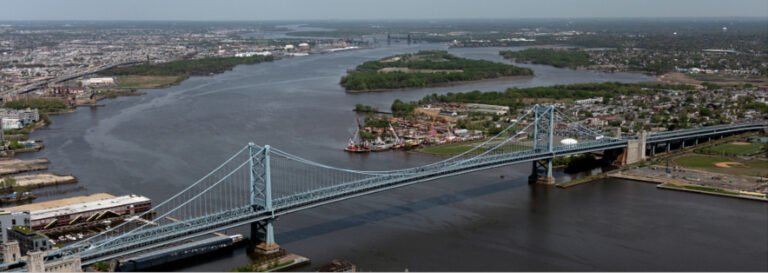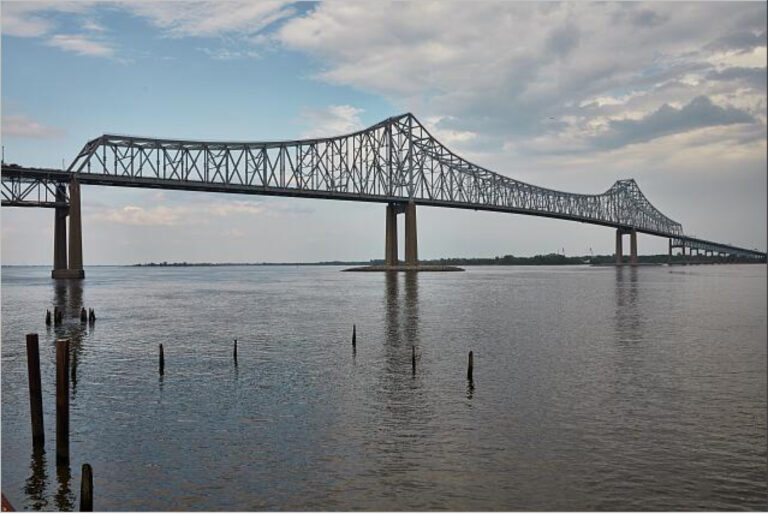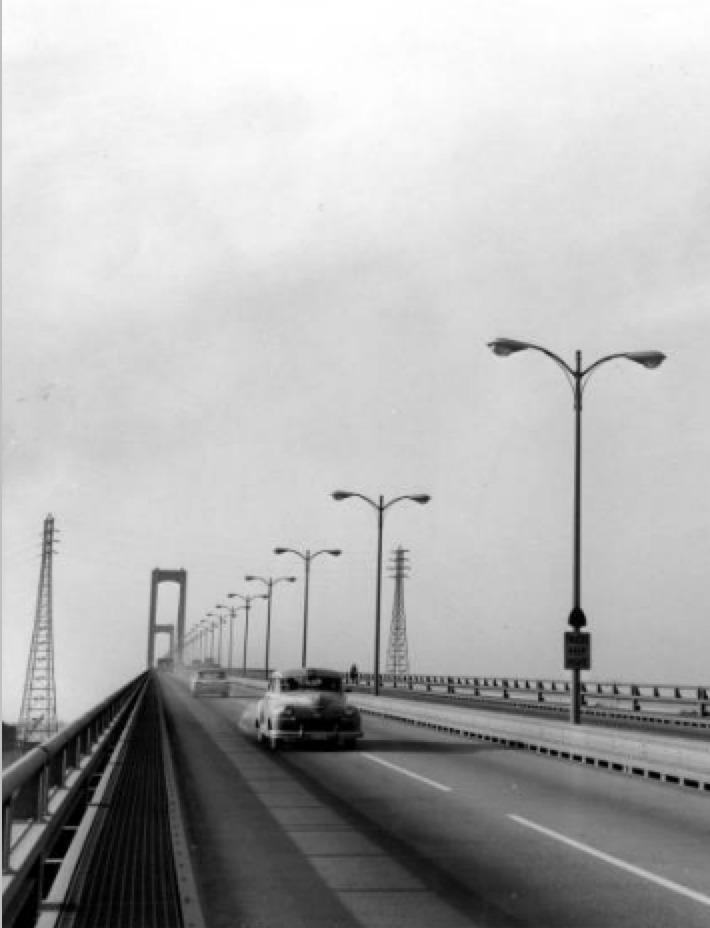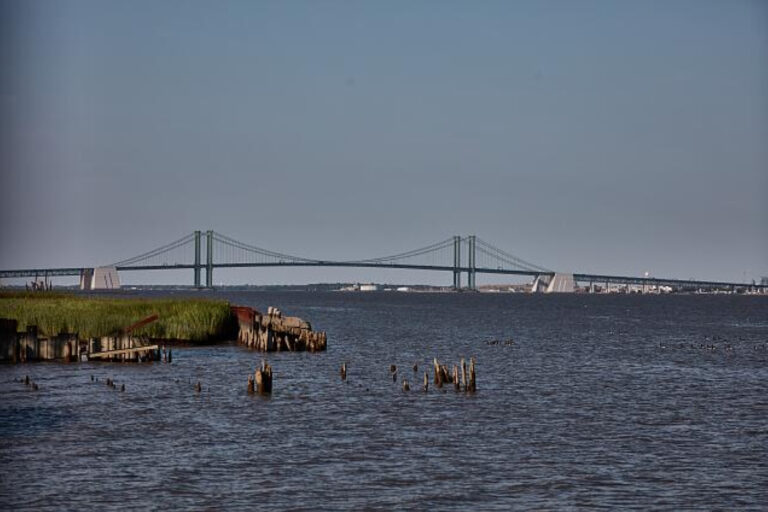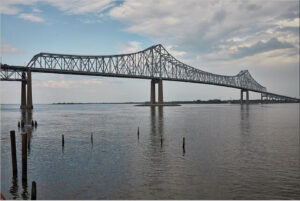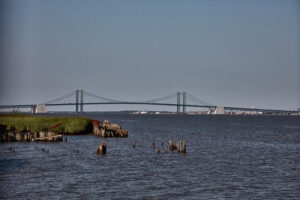Bridges
Essay
Bridge crossings in the Delaware River watershed area have been a measure of the connectedness of the inhabitants with each other and surrounding regions. Through the eighteenth century bridges were of modest size and relatively limited in number. During the nineteenth century the rate of bridge construction rapidly increased, allowing for commerce and travel on an unprecedented scale. It was during this period that bridges were first built across the Schuylkill River stimulating suburban growth and economic expansion in Philadelphia. This growth continued into the twentieth century, prompting the construction of major bridges across the Delaware River including the Benjamin Franklin Bridge, Walt Whitman Bridge, Commodore Barry Bridge, Betsy Ross Bridge, and Delaware Memorial Bridge. These would serve, and help to create, one of the busiest transportation corridors in the country.
The pace of bridge construction was initially slow compared to that in New England and the South. This was partly because the Delaware and Schuylkill Rivers were themselves useful as highways, and so the need to cross them remained limited throughout the seventeenth and eighteenth centuries. The Lenni Lenape who first lived in the area marked good crossing locations along rivers, particularly the Delaware and Schuylkill. These later became sites of ferry crossings, which would eventually foster bridge spans.
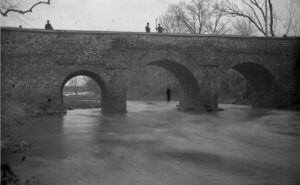
In 1660 King Charles II (1630-85) ordered a road, referred to as the King’s Highway, to be built stretching from Boston, Massachusetts, to Charleston, South Carolina. By 1683, however, progress in Pennsylvania had stalled. Consequently, and at the request of William Penn, that same year the Pennsylvania Provincial Assembly passed a law requiring bridges to be built by local inhabitants across all streams and rivers that intersected the highway. Due to technological limitations, which were just starting to be overcome in New England, these first bridges were not able to span major waterways like the Delaware River. Instead, they typically kept to tributaries and smaller rivers. The earliest surviving bridge built along the King’s Highway in the Delaware watershed area, the Pennypack Creek Bridge, was just such a structure. Completed in 1697, it was stone arch in construction and spanned the Pennypack Creek, located north of Philadelphia where it empties into the Delaware River. Due to the way they facilitated travel, these bridges served as early milestones in the delineation of the region.
Bridges spanning the Delaware and Schuylkill Rivers in Philadelphia were first constructed in the early nineteenth century, and, almost invariably, these river crossings originated as ferry points. Swedish colonists operated the earliest ferries in the 1660s and by the 1730s a significant number of modern-day bridge sites had ferries in operation. On the Schuylkill River these included Gray’s Ferry, the Middle Ferry at Market Street, and the Upper Ferry at Spring Garden Street (all in Philadelphia). On the Delaware these included ferries at Trenton, New Jersey, and upriver at New Hope-Lambertville and Easton-Phillipsburg.
Drawbacks of Ferries
Several factors drove the conversion of ferries to bridges. As early as 1764 timber rafters using the Delaware for transport proved dangerous to ferry passengers. As late as 1914 there was a collision between a raft and a ferry that caused the deaths of four passengers. Also, ferries had to stop operation during flooding and freezing. The greatest impetus, though, was when a ferry could no longer handle the amount of traffic queuing up to cross. At this point a corporation, typically local residents of the towns on either side of the river, would petition the states for a charter to build a bridge. They would then finance construction by selling stock in the company, and dividends (and repairs) would be paid from collected tolls. Thus, privately owned ferries were converted into privately owned toll bridges.
The most heavily trafficked ferries on the Delaware were at Trenton and Easton, which consequently led to the first bridge construction over the river. The Delaware River Bridge Company commissioned the Easton-Phillipsburg Bridge in 1795. However, the Lower Trenton Bridge, though commissioned later, was completed nine months before the Easton bridge in January 1806. New England had achieved greater technical feats in bridge building at the time, and as a result both of these bridges were designed by men whose earlier works were constructed in New York and Massachusetts: the Trenton bridge by Theodore Burr (1771-1822), designer of the first bridge to span the Hudson River, and the Easton bridge by Timothy Palmer (1751-1821), who designed and built the first timber-truss bridge in the United States over the Merrimack River in Massachusetts. Trenton was an ascending manufacturing center and its bridge helped solidify its importance along the route between New York and Philadelphia. Easton-Phillipsburg was initially a small agricultural area, but, through influences such as its bridge, it would become a transportation hub for the steel industry and funnel large quantities of anthracite coal to Philadelphia.
At the same time that these Delaware River bridges were enhancing the route between Philadelphia and New York, bridge construction across the Schuylkill was laying the potential for the expansion of Philadelphia’s suburbs, particularly West Philadelphia. The Schuylkill bridges also generally started as ferry crossings. Technically, the first span across the river was a floating bridge at Gray’s Ferry, built shortly after the Revolutionary War. However, the first significant bridge (that did not need to be pulled aside for passing ships) was finished in 1805 and designed by Timothy Palmer (who would then go on to build the Trenton crossing). It was known as Palmer’s Permanent Bridge at Market Street. A bridge at Spring Street was completed in 1812 in anticipation of traffic from the growing neighborhood of Mantua. At its completion, this Wernwag Bridge was the longest single-span bridge in the world at 343 feet. The ease of access that these bridges provided to neighborhoods that were initially outside the city would be a justification for their inclusion within the city limits set with the 1854 Act of Consolidation.
Railways Played a Role
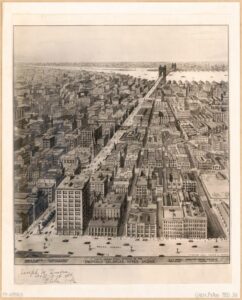
The need for railway bridges spurred further bridge construction across the Schuylkill River, both in Philadelphia and further upriver. In 1838 Gray’s Ferry finally got a proper bridge. Called the Newkirk Viaduct, this was a railway bridge that provided the first direct rail access from Philadelphia to Baltimore. The Philadelphia and Reading Railway opened in 1842 and its multiple crossings as it stretched from Philadelphia to Reading and into northwest Pennsylvania’s coal region (including a major crossing at Norristown) allowed it to compete with the Schuylkill Navigation Company. Its terminus was at Philadelphia and Columbia Railroad on the west side of the Schuylkill River from which point cargo would be transported to Philadelphia’s Reading Terminal via the Columbia Railway Bridge in Fairmount Park.
The bridges over these two major waterways would become more technologically advanced with time. The Pennypack Bridge was a stone arch bridge suitable for modest length bridges over rivers that did not have much down-river traffic. Bridges built in the area, starting with the Permanent and Lower Trenton Bridges, were wooden covered bridges, the Permanent Bridge being the first completely covered bridge in the United States. For wide points in a river these bridges could require many spans (the Lower Trenton Bridge had five), which was a hazard during floods and freshets (spring ice thaws), and for timber rafts. An 1841 flood damaged or destroyed many Delaware River bridges. By some accounts only the Easton and Trenton bridges remained.
Beginning in the 1870s covered bridges were abandoned for steel bridges. These were typically suspension bridges but sometimes truss or cantilever bridges. The last wooden bridge built on the river was the Columbia-Portland bridge (upriver at Knowlton township New Jersey) completed in 1869. After a particularly bad Delaware River flood in 1903, most of the covered bridges were damaged or destroyed and their respective companies repaired or replaced them with steel constructions. Steel was typically required for a bridge to be able to handle railroad traffic for any length of time and was consequently used at Trenton (after an initial attempt at modifying the wooden bridge with track). Other bridges farther upriver on the Delaware were also modified to permit rail traffic, which enhanced access to markets in the northeast, including New York City.
Camden Commuters
Just as development in West Philadelphia required bridges in order to handle the increase in traffic, higher levels of commuter traffic across the Delaware drove plans to connect the city directly to Camden. To this end, the New Jersey and Pennsylvania legislatures created commissions that coalesced as the Delaware River Joint Commission in 1919 (later renamed the Delaware River Port Authority in 1931). Its purpose was the building and maintaining of links between the two states. This initially included a single bridge, which was completed in 1926 and named the Delaware River Bridge (later renamed the Benjamin Franklin Bridge). This would expand to include three more bridges: the Walt Whitman Bridge in 1955, the Commodore Barry Bridge in 1974, and the Betsy Ross Bridge in 1976; the PATCO Speedline in 1969, a mass transit rail line running between Philadelphia and Camden over the Benjamin Franklin Bridge; and a ferry. The Benjamin Franklin and Walt Whitman Bridges are steel suspension bridges, the Commodore Barry Bridge a steel cantilever bridge, and the Betsy Ross a steel truss bridge.
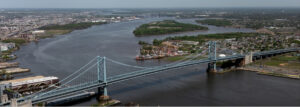
The initial reports conducted by the Delaware River Joint Commission in preparation for the Delaware River Bridge showed that most trans-Delaware traffic crossed using the ferry that ran between Market Street, Camden, and Market Street, Philadelphia. Furthermore, they stressed that nearly two-thirds of this traffic originated locally in Camden, numbering 24.6 million passengers per year. Also, a summary of these reports in 1920 showed that the trend was towards an increasing percentage of traffic across the river that was not local. Therefore, a central conclusion was that, at the time of the construction of the first bridge, it was not economical for the commission to construct an elevated rapid transit system, but that it would be a plan with “attractive features” as traffic patterns shifted in the following decades to higher numbers of long-distance commuters. The bridge itself would act as a catalyst for these trends.
After the completion of the Benjamin Franklin Bridge, demand grew for a connection across the Delaware River between New Jersey and Delaware. A ferry service started in 1926 to meet this demand almost immediately generated a traffic bottleneck with reported automobile lines of up to four miles long on both sides of the river. Despite this, it was not until 1940 that the Delaware General Assembly studied the possibility of a bridge. The project lagged due to World War II, but in 1947 the Delaware River Crossing Division formed and began construction of the Delaware Memorial Bridge. It was completed in 1951, making it the second bridge across the Delaware in the Philadelphia area.
Washington-New York Corridor
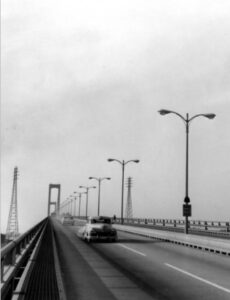
From the Delaware Memorial Bridge’s inception, actual usage far exceeded the estimated projections of traffic (in 1960 it was calculated that traffic was increasing at a 5.7 percent compound growth rate). This was due in part to its strategic location on the north-south route between New York and Washington, as well as its connection to major highways running west. While the Benjamin Franklin Bridge had made it possible for automobile travelers to reach New York without having to use a ferry, now it was possible to avoid traveling through Philadelphia altogether. In 1962 the Delaware River and Bay Authority was created to enhance the first span and build a second, making it a twin suspension bridge, which was completed in 1968.
Further development south of Philadelphia was spurred with the opening of the Walt Whitman Bridge in 1957. It was initially conceived by the Delaware River Port Authority as a way to reduce traffic on the Ben Franklin Bridge and provide an alternative route to South Jersey shore communities. However, at the thirtieth anniversary ceremony of the bridge’s opening commenters noted that while originally many viewed the bridge as just another route to the shore, its larger consequence was to stimulate growth in southeastern Pennsylvania and southern New Jersey. Migrant workers had easier transport between South Philadelphia and southern New Jersey farms, and many ultimately relocated outside of the Philadelphia area. Furthermore, after its construction, the bridge was connected to the Schuylkill Expressway, opening a major route west of the Delaware. The bridge also helped spur the establishment of the Food Distribution Center, the South Philadelphia sports complex, and the expanded use of Philadelphia International Airport.
The Delaware River Port Authority and the Delaware River Joint Toll Bridge Commission (DRJTBC) assumed responsibility for the majority of bridges crossing the Delaware between Pennsylvania and New Jersey. Launched as the Commission for Elimination of Toll Bridges, the DRJTBC was created for two reasons. It would purchase toll bridges along the Delaware River and convert them to free bridge crossings and use equal annual subsidies from both states to maintain the bridges. From 1920 to 1934 the commission purchased, repaired, and consolidated many bridge crossings on the river. In 1934 it was replaced with the DRJTBC, with responsibility to maintain a total of twelve toll-free bridges out of joint tax subsidies and maintain eight toll bridges including the Easton-Phillipsburg (U.S. Route 22) Bridge and Trenton-Morrisville (U.S. Route 1) Bridge (Lower Trenton Bridge). Although many of these and the Schuylkill’s bridges were prompted by need, once completed they had a profound impact in altering patterns of travel and commerce, thus helping establish the distinct character of the region.
Andrew Slemmon is a graduate student in the Department of History at West Chester University. (Author information current at the time of publication.)
Bridge Construction Types
Arch – A bridge whose substructure is composed of arches.
Truss – The load-bearing structure (truss) is composed of a series of connected elements, typically triangles.
Suspension – The roadway is hung below suspension cables (via vertical supporting cables), which transport tension to towers at either end of the bridge.
Cantilever – Each half of the bridge is a rigid structural element supported at one end only (a cantilever), which extends out over the river.
Bridges
Abbreviations of proprietors:
DRPA – Delaware River Port Authority.
DRJTBC – Delaware River Joint Toll Bridge Commission.
PennDOT – Pennsylvania Department of Transportation.
Benjamin Franklin Bridge: Delaware River between Philadelphia and Camden, suspension bridge, DRPA, opened 1926.
Walt Whitman Bridge: Delaware River between Philadelphia and Gloucester, suspension bridge, DRPA, opened 1957.
Commodore Barry Bridge: Delaware River between Chester and Bridgeport, cantilever bridge, DRPA, opened 1974.
Betsy Ross Bridge: Delaware River between Philadelphia and Pennsauken, truss bridge, DRPA, opened 1976.
Delaware Memorial Bridge: Delaware River between New Castle and Deepwater, twin suspension bridge, Delaware River and Bay Authority, opened 1951.
Tacony-Palmyra Bridge: Delaware River between Philadelphia and Palmyra, tied-arch bridge, Burlington County Bridge Commission, opened 1929.
Burlington-Bristol Bridge: Delaware River between Bristol Township and Burlington, truss bridge, Burlington County Bridge Commission, opened 1931.
Milford-Montague Toll Bridge: Delaware River between Milford and Montague Township, truss birdge, DRJTBC, opened 1953.
Delaware Watergap Toll Bridge: Delaware River between Delaware Water Gap and Hardwick Township, steel plate beam bridge, DRJTBC, opened 1953.
Portland-Columbia Toll Bridge: Delaware River between Portland and Columbia, girder bridge, DRJTBC, opened 1953.
Easton-Phillipsburg Toll Bridge: Delaware River between Easton and Phillipsburg, truss bridge, DRJTBC, opened 1938.
I-78 Toll Bridge: Delaware River between Williams Township and Phillipsburg, twin girder bridge, DRJTBC, opened 1989.
New Hope-Lambertville Toll Bridge: Delaware River between Solebury Township and Delaware Township, girder bridge, DRJTBC, opened 1971.
Scudder Falls Toll Bridge: Delaware River between Lower Makefield Township and Ewing Township, plate girder bridge, DRJTBC, opened 1961.
Trenton-Morrisville Toll Bridge: Delaware River between Morrisville and Trenton, girder bridge, DRJTBC, opened 1952.
Portland Columbia Bridge: Delaware River between Portland and Columbia, truss bridge, DRJTBC, opened 1957.
Riverton-Belvidere Bridge: Delaware River between Riverton and Belvidere, truss bridge, DRJTBC, opened 1904.
Northampton Street Bridge: Delaware River between Easton and Phillipsburg, cantilever bridge, DRJTBC, opened 1896.
Riegelsville Bridge: Delaware River between Riegelsville and Pohatcong Township, suspension bridge, DRJTBC, opened 1904.
Upper Black Eddy-Milford Bridge: Delaware River between Upper Black Eddy and Milford, truss bridge, DRJTBC, opened 1933.
Uhlerstown-Frenchtown Bridge: Delaware River between Uhlerstown and Frenchtown, truss bridge, DRJTBC, opened 1931.
Lumberville-Raven Rock Bridge: Delaware River between Lumberville and Raven Rock, truss bridge, DRJTBC, opened 1904.
Center Bridge-Stockton Bridge: Delaware River between Center Bridge and Stockton, truss bridge, DRJTBC, opened 1927.
New Hope-Lambertville Bridge: Delaware River between New Hope and Lambertville, truss bridge, DRJTBC, opened 1904.
Washington Crossing Bridge: Delaware River between Upper Makesfield Township and Hopewell Township, truss bridge, DRJTBC, opened 1904.
Calhoun Street Bridge: Delaware River between Morrisville and Trenton, truss bridge, DRJTBC, opened 1884.
Lower Trenton Bridge: Delaware River between Morrisville and Trenton, truss bridge, DRJTBC, opened 1928.
Market Street Bridge: Schuylkill River in Philadelphia, arch bridge, City of Philadelphia, opened 1932.
Walnut Street Bridge: Schuylkill River in Philadelphia, truss bridge, City of Philadelphia, opened 1893.
Spring Garden Bridge: Schuylkill River in Philadelphia, girder bridge, City of Philadelphia, opened 1965.
Gray’s Ferry Bridge: Schuylkill River in Philadelphia, girder bridge, State Highway Agency, opened 1976.
Girard Avenue Bridge: Schuylkill River in Philadelphia, girder bridge, City of Philadelphia, opened 1972.
Strawberry Mansion Bridge: Schuylkill River in Philadelphia, arch truss bridge, City of Philadelphia, opened 1897.
Vine Street Expressway Bridge: Schuylkill River in Philadelphia, girder bridge, PennDOT, opened 1959.
Schuylkill Expressway Bridge: Schuylkill River in Philadelphia, girder bridge, PennDOT, opened 1956.
Columbia Railway Bridge: Schuylkill River in Philadelphia, arch bridge, City of Philadelphia, opened 1920.
Schuylkill River Bridge: Schuylkill River between Swedesburg and Black Horse, girder bridge, Pennsylvania Turnpike Commission, opened 1954.
Copyright 2022, Rutgers University.
Gallery
Links
- The Art Museum that's also a Bridge (PhillyVoice)
- Making Connections in New Jersey with the Delair Bridge (Hidden City Philadelphia)
- The Origins of the Eagles on the Market Street Bridge (Hidden City Philadelphia)
- Falls Bridge Historical Nomination (pdf, Phila.gov)
- Naming Bridges in the 1950s: Benjamin Franklin and Walt Whitman (PhillyHistory Blog)
- The Walnut Lane Bridge: Poetry in Poured Concrete (PhillyHistory Blog)
- Collapse of the South Street Bridge (PhillyHistory Blog)
- Creativity in Cast Iron: Strickland Kneass's Chestnut Street Bridge (PhillyHistory Blog)
